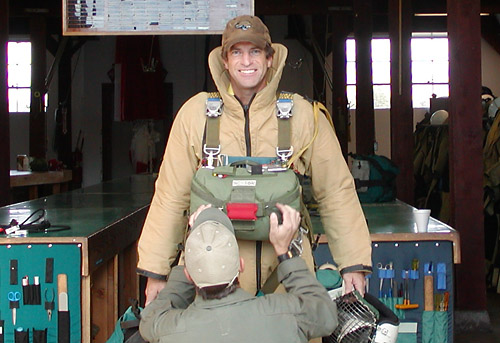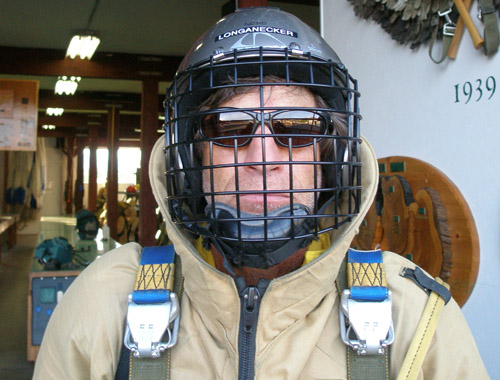|
Recordholder Retires
Roland Giller, Okanogan-Wenatchee National Forest
 Dale Longanecker receives a spotter's check by former North Cascades Smokejumper Base Manager Steve Dickinson before boarding a smokejuper aircraft. Spotter's checks are done to ensure parachute equipment is in proper working order (USFS photo). Dale Longanecker will retire September 30, after completing 893 U.S. Forest Service parachute jumps—a record unlikely to ever be broken given the longevity of his 38-year smokejumping career.
Longanecker, 57, knew he wanted to be a smokejumper when he was eight years old and watched his cousin complete smokejumper training at the North Cascades Smokejumper Base (NCSB).
His older brothers Dean and Ernie became smokejumpers at NCSB before he completed rookie smokejumper training at the Redmond Air Center in 1974 when he was 19. He transferred to NCSB in 1977.
Longanecker grew up in Winthrop about five miles from NCSB and lived next door to Francis Lufkin. Lufkin made the first Forest Service parachute jumps with Glenn Smith in 1939 at Little Bridge Creek, ten miles west of NCSB.
 After 38 years and 893 parachute jumps for the Forest Service Dale Longanecker was only seriously injured once. “I kinda grew up around it,” Longanecker said about smokejumping. “It was just kinda something you did.”
Longanecker’s 893 total Forest Service parachute jumps include practice, fire suppression and rescue jumps. His record includes 362 fire jumps. Smokejumpers often make a distinction between practice and fire suppression jumps because the latter are often more hazardous and located far from medical assistance.
Longanecker was seriously injured only once during his career from downdrafts on a fire jump in 1979. He broke both ankles on a rock.
“A good (parachute) roll is important,” he said, referring to the roll smokejumpers are trained to complete upon landing on the ground. He believes mastering the maneuver was instrumental in remaining mostly injury-free for so many years.
Longanecker said the excitement of parachuting to forest fires was not the reason he jumped for 38 years. “It was the opportunity to be on small fires in remote locations,” he said. “It was just a great way to see the country.”
Longanecker is the NCSB parachute loft supervisor and an FAA-approved master parachute rigger. He worked with the Forest Service’s Missoula Technology and Development Center before retirement to develop an FS-15 parachute prototype. The new parachute will potentially replace the FS-14 parachute now used by all Forest Service smokejumpers.
|
